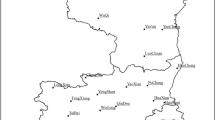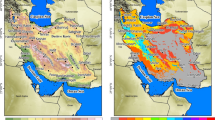Abstract
Extreme climate index is one of the useful tools to monitor and detect climate change. The primary objective of this study is to provide more comprehensively the changes in precipitation and temperature extremes for the period of 1959–2015 in the Jing-Jin-Ji metropolitan region of China, including Beijing city, Tianjin city and Hebei province, which will hopefully provide scientific understanding of the precipitation and temperature-related natural hazards such as flood, drought and heat wave. Daily precipitation and temperature from 26 surface meteorological stations over the study area were used to calculate 14 extreme precipitation indices (EPIs) and 17 extreme temperature indices (ETIs) generated by the joint World Meteorological Organization Commission for Climatology (CCI)/World Climate Research Programme (WCRP) project on Climate Variability and Predictability (CLIVAR) Expect Team on Climate Change Detection, Monitoring and Indices (ETCCDMI). The EPIs and ETIs were generated using the RClimRex software, and the trends were analyzed using the Mann-Kendall non-parametric test and the Thiel-Sen’s slope estimator. The results showed the following: (1) The spatiotemporal variability for daily climate extremes varied for both the EPIs and ETIs between 1959 and 2015. In the case of the EPIs, most of the indices were negative trend-dominated, and for the ETIs, 13 ETIs were positive trend-dominated, and six ETIs were negative trend-dominated. (2) Six types of precipitation intensity EPIs including the R10mm–R250mm were especially defined to detect impacts of climate change on the precipitation events. The results showed that the spatial distributions of increasing trends for these EPIs were similar, mainly located at the south of the Hebei province. (3) In general, the trend magnitudes of fixed-threshold extreme indices were smaller than those of station-related thresholds and non-threshold extreme indices for both the EPIs and ETIs. (4) The spatial distributions of positive and negative trends for both the EPIs and ETIs were scattered. For several indices such as the ID0, SU25, WSDI and TX90p, stations that had statistically significant increasing/decreasing trends at 5% significance level were detected mainly located at the north of the Jing-Jin-Ji metropolitan region. More works on the physical mechanisms behind the varied changes and scattered spatial distributions of trends in the Jing-Jin-Ji metropolitan region are recommended as an extension of this study.









Similar content being viewed by others
References
Abatan AA, Abiodun BJ, Lawal KA et al (2015) Trends in extreme temperature over Nigeria from percentile-based threshold indices. Int J Climatol 36:2527–2540
Abbas F, Ahmad A, Safeeq M et al (2014) Changes in precipitation extremes over arid to semiarid and subhumid Punjab, Pakistan. Theor Appl Climatol 116:671–680
Alexander L, Zhang X, Peterson T, et al. (2006) Global observed changes in daily climate extremes of temperature and precipitation (1984–2012). J Geophys Res Atmos 111:D05109:1–22
Alexander L, Uotila P, Nicholls N (2009) Influence of sea surface temperature variability on global temperature and precipitation extremes. J Geophys Res-Atmos 114:D18116:1–13
Almazroui M, Islam MN, Dambul R et al (2014) Trends of temperature extremes in Saudi Arabia. Int J Climatol 34:808–826
Beharry SL, Clarke RM, Kumarsingh K (2015) Variations in extreme temperature and precipitation for a Caribbean island: Trinidad. Theor Appl Climatol 122:783–797
Bonsal BR, Zhang X, Vincent LA et al (2001) Characteristics of daily and extreme temperatures over Canada. J Clim 14:1959–1976
Choi G, Collins D, Ren G et al (2009) Changes in means and extreme events of temperature and precipitation in the Asia-Pacific Network region, 1955–2007. Int J Climatol 29:1906
Croitoru AE, Chiotoroiu BC, Todorova VI et al (2013) Changes in precipitation extremes on the Black Sea Western Coast. Glob Planet Chang 102:10–19
dos Santos CAC, Neale CMU, Rao TVR et al (2011) Trends in indices for extremes in daily temperature and precipitation over Utah, USA. Int J Climatol 31:1813–1822
Emori S (2005) Dynamic and thermodynamic changes in mean and extreme precipitation under changed climate. Geophys Res Lett 32:L17706:1–5
Hamed KH (2009) Exact distribution of the Mann-Kendall trend test statistic for persistent data. J Hydrol 365:86–94
Jiang R, Gan TY, Xie J et al (2014) Spatiotemporal variability of Alberta’s seasonal precipitation, their teleconnection with large-scale climate anomalies and sea surface temperature. Int J Climatol 34:2899–2917
Jiang R, Xie J, He H et al (2015) Use of four drought indices for evaluating drought characteristics under climate change in Shaanxi, China: 1951–2012. Nat Hazards 75:2885–2903
Jiang R, Xie J, Zhao Y, et al. (2016) Spatiotemporal variability of extreme precipitation in Shaanxi province under climate change. Theor Appl Climatol 130:831–845
Kan K (2016) Jing-Jin-Ji: integrating a Chinese megapolis. World Policy J 33:5–10
Li J, Dong WJ, Yan ZW (2012a) Changes of climate extremes of temperature and precipitation in summer in eastern China associated with changes in atmospheric circulation in East Asia during 1960–2008. Chin Sci Bull 57:1856–1861
Li ZX, He YQ, Wang PY et al (2012b) Changes of daily climate extremes in southwestern China during 1961–2008. Glob Planet Chang 80-81:255–272
Liu WL, Zhang MJ, Wang SJ et al (2013) Changes in precipitation extremes over Shaanxi Province, northwestern China, during 1960–2011. Quat Int 313:118–129
Lu C, Sun Y, Wan H et al (2016) Anthropogenic influence on the frequency of extreme temperatures in China. Geophys Res Lett 43:6511–6518
Łupikasza EB, Hänsel S, Matschullat J (2011) Regional and seasonal variability of extreme precipitation trends in southern Poland and central-eastern Germany 1951-2006. Int J Climatol 31:2249–2271
Marofi S, Sohrabi MM, Mohammadi K et al (2011) Investigation of meteorological extreme events over coastal regions of Iran. Theor Appl Climatol 103:401–412
Nemec J, Gruber C, Chimani B et al (2013) Trends in extreme temperature indices in Austria based on a new homogenised dataset. Int J Climatol 33:1538–1550
Orlowsky B, Seneviratne SI (2012) Global changes in extreme events: regional and seasonal dimension. Clim Chang 110:669–696
Pachauri RK, Allen M, Barros V, et al (2014) Climate change 2014: synthesis report. Contribution of Working Groups I, II and III to the Fifth Assessment Report of the Intergovernmental Panel on Climate Change
Peterson T (2005) Climate change indices. WMO Bull 54:83–86
Qin NX, Chen X, GB F et al (2010) Precipitation and temperature trends for the Southwest China: 1960–2007. Hydrol Process 24:3733–3744
Salmi T (2002) Detecting trends of annual values of atmospheric pollutants by the Mann-Kendall test and Sen’s slope estimates—the Excel template application MAKESENS. Ilmatieteen laitos
Sen Roy S, Balling RC (2004) Trends in extreme daily precipitation indices in India. Int J Climatol 24:457–466
Sen Roy S, Balling RC (2009) Evaluation of extreme precipitation indices using daily records (1910–2000) from India. Weather 64:149–152
Seneviratne SI, Nicholls N, Easterling D, et al (2012) Changes in climate extremes and their impacts on the natural physical environment. In: Managing the risks of extreme events and disasters to advance climate change adaptation. A special report of working groups I and II of the intergovernmental panel on climate change (IPCC). Cambridge University Press, Cambridge, p 109–230
Seneviratne SI, Donat MG, Mueller B et al (2014) No pause in the increase of hot temperature extremes. Na. Clim Chang 4:161–163
Shadmani M, Marofi S, Roknian M (2012) Trend Analysis in Reference Evapotranspiration Using Mann-Kendall and Spearman's Rho Tests in Arid Regions of Iran. Water Resour Manag 26:211–224
Sheffield J, Wood EF, Roderick ML (2012) Little change in global drought over the past 60 years. Nature 491:435–438
Song X, Zhang J, AghaKouchak A et al (2014) Rapid urbanization and changes in trends and spatio-temporal characteristics of precipitation in the Beijing metropolitan area. J Geophys Res - Atmos 119:11250–11271
Utsumi N, Seto S, Kanae S, et al (2011) Does higher surface temperature intensify extreme precipitation? Geophys Res Lett 38;L16708:1–5
Yue S, Wang CY (2004) The Mann-Kendall test modified by effective sample size to detect trend in serially correlated hydrological series. Water Resour Manag 18:201–218
Yue S, Pilon P, Phinney B et al (2002) The influence of autocorrelation on the ability to detect trend in hydrological series. Hydrol Process 16:1807–1829
Zhai LX, Feng Q (2009) Spatial and temporal pattern of precipitation and drought in Gansu Province, Northwest China. Nat Hazards 49:1–24
Zhai P, Sun A, Ren F et al (1999) Changes of climate extremes in China. Clim Chang 42:203–218
Zhai P, Zhang X, Wan H et al (2005) Trends in total precipitation and frequency of daily precipitation extremes over China. J Clim 18:1096–1108
Zhang X, Yang F (2004) RClimDex (1.0) user manual. Climate Research Branch Environment Canada 22
Zhang X, Hogg WD, Mekis E (2001) Spatial and temporal characteristics of heavy precipitation events over Canada. J Clim 14:1923–1936
Zhang X, Aguilar E, Sensoy S, et al (2005a) Trends in Middle East climate extreme indices from 1950 to 2003. J Geophys Res Atmos 110:D22104:1–12
Zhang X, Hegerl G, Zwiers FW et al (2005b) Avoiding inhomogeneity in percentile-based indices of temperature extremes. J Clim 18:1641–1651
Zhang S, Tao F, Zhang Z (2016) Changes in extreme temperatures and their impacts on rice yields in southern China from 1981 to 2009. Field Crop Res 189:43–50
Ziegler AD (2012) Reduce urban flood vulnerability. Nature 481:145
Acknowledgements
The study was partly supported by the National Key Research and Development Program of China (2016YFC0401409), The National Natural Science Foundation of China (51509201, 51679188), China Postdoctoral Science Foundation (2016M590964), Young Talent Fund of the University Association for Science and Technology in Shaanxi, China (20160217) and the Research Foundation of State Key Laboratory Base of Eco-Hydraulic Engineering in Arid Area (2017ZZKT-6, 2017KFKT-1). The China Meteorological Data Sharing Service System (available at http://cdc.nmic.cn) provided the daily precipitation and temperature. The software packages for EPI and ETI calculation (RClimDex) are available at http://etccdi.pacificclimate.org. The authors thank the editor and anonymous reviewers for their valuable comments and suggestions.
Author information
Authors and Affiliations
Corresponding authors
Rights and permissions
About this article
Cite this article
Jiang, R., Yu, X., Xie, J. et al. Recent changes in daily climate extremes in a serious water shortage metropolitan region, a case study in Jing-Jin-Ji of China. Theor Appl Climatol 134, 565–584 (2018). https://doi.org/10.1007/s00704-017-2293-4
Received:
Accepted:
Published:
Issue Date:
DOI: https://doi.org/10.1007/s00704-017-2293-4




